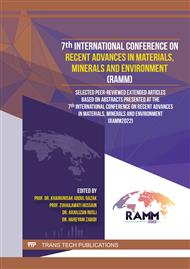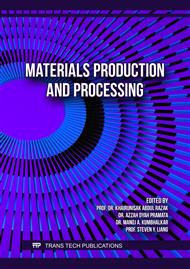[1]
C. Prakash, H.K. Kansal, B.S. Pabla, S. Puri, A. Aggarwal, Electric discharge machining – a potential choice for surface modification of metallic implants for orthopedic applications: a review, Proc. Inst. Mech. Eng. Part B: J. Eng. Manuf. 230 (2016) 331-353.
DOI: 10.1177/0954405415579113
Google Scholar
[2]
D. Raza, G. Kumar, M. Uzair, M.K. Singh, D. Sultan, R. Kumar, Development and heat treatment of β-phase titanium alloy for orthopedic application, Mater. Today: Proc. 50 (2022) 649-654.
DOI: 10.1016/j.matpr.2021.03.665
Google Scholar
[3]
F. C. Campbell, Elements of Metallurgy and Engineering Alloys, ASM International, United States of America, 2008.
Google Scholar
[4]
H. Attar, S. Ehtemam-Haghighi, N. Soro, D. Kent, M. S. Dargusch, Additive manufacturing of low-cost porous titanium-based composites for biomedical applications: advantages, challenges and opinion for future development, J. Alloys Compd. 827 (2020) 154263.
DOI: 10.1016/j.jallcom.2020.154263
Google Scholar
[5]
J. Alipal, N.A.S Mohd Pu'ad, N.H.M. Nayan, N. Sahari, H.Z. Abdullah, M.I. Idris, T.C. Lee, An updated review on surface functionalization of titanium and its alloys for implants applications, Mater. Today: Proc. 42 (2021) 270-282.
DOI: 10.1016/j.matpr.2021.01.499
Google Scholar
[6]
B. O'Brien, Niobium biomaterials, in: M. Niinomi, C.J. Boehlert (Eds.), Advances in Metallic Biomaterials, Springer, New York, 2015, p.245–272. Springer.
Google Scholar
[7]
L. Fikeni, K.A. Annan, K. Mutombo, R. Machaka, Effect of Nb content on the microstructure and mechanical properties of binary Ti-Nb alloys, Mater. Today: Proc. 38 (2021) 913–917.
DOI: 10.1016/j.matpr.2020.05.315
Google Scholar
[8]
D. Zhao, K. Chang, T. Ebel, M. Qian, R. Willumeit, M. Yan, F. Pyczak, Microstructure and mechanical behavior of metal injection molded Ti-Nb binary alloys as biomedical material, J. Mech. Behav. Biomed. Mater. 28 (2013) 171–182.
DOI: 10.1016/j.jmbbm.2013.08.013
Google Scholar
[9]
Y. Chen, P. Han, A. Dehghan-Manshadi, D. Kent, S. Ehtemam-Haghighi, C. Jowers, M. Bermingham, T. Li, J. Cooper-White, M. S. Dargusch, Sintering and biocompatibility of blended elemental Ti-xNb alloys, J. Mech. Behav. Biomed. Mater. 104 (2020) 103691.
DOI: 10.1016/j.jmbbm.2020.103691
Google Scholar
[10]
M. R. Siti Nur Hazwani, L. X. Lim, Z. Lockman, H. Zuhailawati, Fabrication of titanium-based alloys with bioactive surface oxide layer as biomedical implants: opportunity and challenges, T. Nonferr. Metal Soc. 32 (2022) 1-44.
DOI: 10.1016/s1003-6326(21)65776-x
Google Scholar
[11]
Q. -Z. Chen, G. A. Thouas, Metallic implant biomaterials, Mater. Sci. Eng. R Rep. 87 (2015) 1-57.
Google Scholar
[12]
S.N. Tedman-Jones, S.D. McDonald, M.J. Bermingham, D.H. StJohn, M.S. Dargusch, A new approach to nuclei identification and grain refinement in titanium alloys, J. Alloys Compd. 794 (2019) 268-284.
DOI: 10.1016/j.jallcom.2019.04.224
Google Scholar
[13]
V. Bousson, C. Bergot, A. Meunier, F. Barbot, C. Parlier-Cuau, A.-M. Laval-Jeantet, J.-D. Laredo, CT of the middiaphyseal femur: cortical bone mineral density and relation to porosity, Radiology 217 (2000) 179-187.
DOI: 10.1148/radiology.217.1.r00se11179
Google Scholar
[14]
Q. Wang, C. Han, T. Choma, Q. Wei, C. Yan, B. Song, Y. Shi, Effect of Nb content on microstructure, property and in vitro apatite-forming capability of Ti-Nb alloys fabricated via selective laser melting, Mater. Des. 126 (2017) 268-277.
DOI: 10.1016/j.matdes.2017.04.026
Google Scholar
[15]
F. N. Ahmad, H. Zuhailawati, A brief review on the properties of titanium as a metallic biomaterials, Int. J. Electroactive Mater. 8 (2020) 63-67.
Google Scholar



